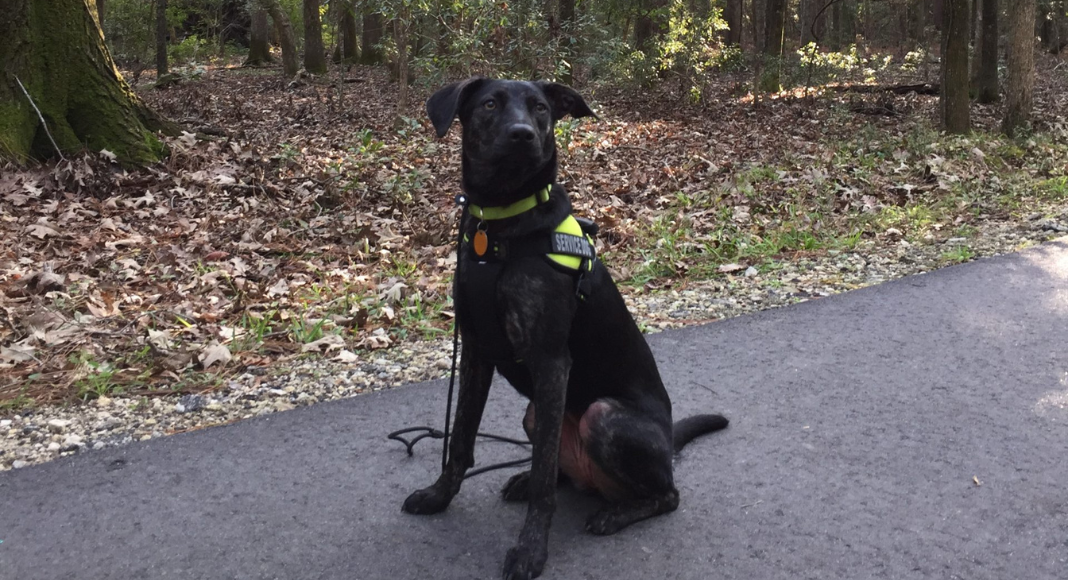I never thought I would be the kind of person to take her dog everywhere with her. I love my dogs wholeheartedly, but asking one of them to come to the grocery store with me seemed like asking just a little too much from them – until I met Cricket.
Cricket is my now-retired service dog, but she spent several years working with me to make my daily life more manageable and help me achieve my goals.
Adding Cricket to our family wasn’t part of my five-year plan. We decided to add her on impulse when my post-traumatic stress disorder and bipolar disorder made my day-to-day life feel almost impossible. Training her and knowing that I could rely on her to help me navigate through my days was sometimes the only reason I could do something as simple as going to the grocery store to pick up a gallon of milk.
 Because I had never thought about adding a service dog to my family, I also didn’t really think about how other people view service dogs in the general public.
Because I had never thought about adding a service dog to my family, I also didn’t really think about how other people view service dogs in the general public.
What to Remember When You See Service Dogs in Public
Here are a few fun facts for National Service Dog Month that you should know about service dogs to help handlers feel more at ease bringing their canine companions out in public. For many of us, bringing our dogs is simply the only way we will be able to keep up with our daily agendas. Do what you can to make it easier for all involved.
1. Service Dogs are NOT Just Pets
The general consensus as far as I have seen is that people believe all dogs are pets. While a service dog is certainly a pet to some extent, they are also a bona fide member of the family. They have an important job to do, and many of them spend years training to do that job to the best of their ability.
While they often look cute, cuddly, and friendly, this is not their ultimate purpose in life. A true service dog performs a specific task that mitigates a disability (mental or physical). For example, Cricket knows how to interrupt panic attacks and keep people from getting too close to me when we stand in line at the store (among other things).
2. No Petting is Allowed
As a result of her adorable looks and pleasant disposition, I see many people who dote on my service dog. I want you to know that she receives plenty of love and attention when she’s off the clock. Service dogs don’t need your attention. This distraction could cause them to miss a signal for task work that mitigates their handler’s disability.
Oftentimes, you will see people put “no petting” tags on their service dog’s vest so that they don’t have to answer this question for others and incur even more stress from an already difficult trip to the store. (As a side note: always teach your kids to ask before they pet a strange dog! Even if you see them in the store, it’s better to be safe than sorry.)
3. Don’t Draw More Attention
I know how novel it is to see a dog strolling with their owner in the shampoo aisle at Target. As a handler myself, I also know that bringing my dog with me draws even more unwanted attention to me, which makes it that much harder for me to force myself to run those much-needed errands.
Do your best to keep stares to a minimum, even if you think that a dog in a service vest is the cutest thing you’ve ever seen.
Most service dog handlers already know that their dog is extremely well-behaved – it wouldn’t be a service dog if it couldn’t behave in public settings. I prefer it when nobody comments on Cricket’s behavior at all when we go out. She should be like an invisible sidekick who is there just to help me work through something difficult.
4. Teach Your Kids About Working Dogs
Teach your kids what it means if you see a dog in a vest at the grocery store or even the pet store. Dogs are capable of doing some amazing things for their handlers, from police work to service work. Teaching your child how to interact with service dogs (and dogs in general) is important for the safety and comfort of almost everyone.
I never mind having a conversation with a child about what special things my dog can do, but it helps if their parents educate them when they see a service dog out in public first. It takes away the sting of disappointment when I tell them that they can’t pet Cricket while she’s working, even if she looks like she isn’t doing much to the naked eye.
Service dogs are a major blessing to those of us who have them. I hope that next time you see one out and about with their handler you’ll think of some of these tips to make the experience more positive for everyone!













